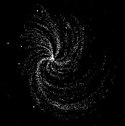Messier 99
 Galaktyka spiralna M99 (Mount Lemmon SkyCenter) | |
| Odkrywca | |
|---|---|
| Data odkrycia | 15 marca 1781 |
| Dane obserwacyjne (J2000) | |
| Gwiazdozbiór | |
| Typ | |
| Rektascensja | 12h 18m 49,625s[1] |
| Deklinacja | +14° 24′ 59,36″[1] |
| Odległość | |
| Przesunięcie ku czerwieni | 0,008036 ±0,000020[1] |
| Jasność obserwowana | |
| Rozmiary kątowe | 5,4' × 4,8'[2] |
| Charakterystyka fizyczna | |
| Wymiary | 94 × 84 tys. ly |
| Alternatywne oznaczenia | |
| NGC 4254, UGC 7345, HIPASS J1218+14, IRAS F12163+1441, LEDA 39578, PGC 39578,[M98c] 121616.9+144146, MCG+03-31-099, VCC 307, Z 1216.3+1442, Z 98 – 144 | |
 Gwiazdozbiór Warkocza Bereniki | |
Messier 99 (również M99, NGC 4254, PGC 39578 lub UGC 7345) – galaktyka spiralna znajdująca się w gwiazdozbiorze Warkocza Bereniki. Jedna z jaśniejszych galaktyk w Gromadzie w Pannie. Odkrył ją 15 marca 1781 Pierre Méchain wraz z leżącymi w pobliżu M98 i M100. Charles Messier zmierzył jej pozycję i dodał do swojego katalogu 13 kwietnia 1781, niedługo przed ukończeniem jego trzeciej, końcowej wersji[2].
Opis galaktyki

M99 znajduje się w odległości ok. 60 milionów lat świetlnych od Ziemi i oddala się z prędkością ok. 2324 km/s[2]. Wymiary galaktyki wynoszą około 94 × 84 tysiące lat świetlnych.
Cechą szczególną M99 są jej niesymetryczne przekrzywienie oraz rozciągnięte ramię spiralne. Zazwyczaj jest to skutkiem oddziaływania grawitacji sąsiedniej galaktyki, jednak w wypadku Messier 99 takiego sąsiada nie znaleziono. Wygląd M99 może być spowodowany oddziaływaniem z ciemną galaktyką VIRGOHI21, która przyciąga gaz powodując rozciąganie jednego z ramion spiralnych[3].
Supernowe

Do tej pory w M99 zaobserwowano cztery supernowe[2]:
- SN 1967H – supernowa typu II z czerwca 1967, osiągnęła jasność 14m
- SN 1972Q – 16 grudnia 1972, typ II, osiągnęła jasność 15,6m
- SN 1986I – 17 maja 1986, typ I, jasność 14m
- SN 2014L – 26 stycznia 2014, typ Ic, jasność 15,4m
Zobacz też
Przypisy
- ↑ a b c d e Messier 99 w bazie SIMBAD (ang.)
- ↑ a b c d e Messier 99 w SEDS.org (ang.)
- ↑ Adrian Majecki: Nowe dowody dotyczące VIRGOHI 21 (pol.). W: New evidence for a Dark Matter Galaxy [on-line]. PPARC, 2006-01-13. [dostęp 2011-08-15].
Linki zewnętrzne
- Messier 99 w NASA/IPAC Extragalactic Database (ang.)
- Messier 99 w bazie SIMBAD (ang.)
- Courtney Seligman: NGC 4254 (ang.). Celestial Atlas. [dostęp 2015-07-17].
Media użyte na tej stronie
Autor: Original uploader was Blueshade at pl.wikipedia, Licencja: CC-BY-SA-3.0
Ta mapa gwiazdozbioru została stworzona przy pomocy programu PP3 autorstwa Torstena Brongera. Tłumaczenia na język polski oraz innych modyfikacji na potrzeby polskiej Wikipedii dokonał Przemysław 'BlueShade' Idzkiewicz. Grafika udostępniona jest na licencji GFDL w wersji 1.2 lub nowszej.
Autor: Credit Line and Copyright Adam Block/Mount Lemmon SkyCenter/University of Arizona, Licencja: CC BY-SA 3.0 us
Picture Details:
Optics 32-inch Schulman Telescope (RC Optical Systems), Acquired remotely Camera SBIG STX 16803 CCD Camera Filters AstroDon Gen II Dates January 2012 Location Mount Lemmon SkyCenter Exposure LRGB = 250:70:70:70 minutes Acquisition ACP Observatory Control Software (DC-3 Dreams),TheSky (Software Bisque), Maxim DL/CCD (Cyanogen) Processing CCDStack (CCDWare), Photoshop CS5 (Adobe), PixInsightCredit Line and Copyright Adam Block/Mount Lemmon SkyCenter/University of Arizona
Autor: ESA/Hubble & NASA. Acknowledgement: Matej Novak, Licencja: CC BY 3.0
This image, taken by the NASA/ESA Hubble Space Telescope, shows a detailed view of the spiral arms on one side of the galaxy Messier 99. Messier 99 is a so-called grand design spiral, with long, large and clearly defined spiral arms — giving it a structure somewhat similar to the Milky Way.
Lying around 50 million light-years away, Messier 99 is one of over a thousand galaxies that make up the Virgo Cluster, the closest cluster of galaxies to us. Messier 99 itself is relatively bright and large, meaning it was one of the first galaxies to be discovered, way back in the 18th century. This earned it a place in Charles Messier’s famous catalogue of astronomical objects.
In recent years, a number of unexplained phenomena in Messier 99 have been studied by astronomers. Among these is the nature of one of the brighter stars visible in this image. Catalogued as PTF 10fqs, and visible as a yellow-orange star in the top-left corner of this image, it was first spotted by the Palomar Transient Facility, which scans the skies for sudden changes in brightness (or transient phenomena, to use astronomers’ jargon). These can be caused by different kinds of event, including variable stars and supernova explosions.
What is unusual about PTF 10fqs is that it has so far defied classification: it is brighter than a nova (a bright eruption on a star’s surface), but fainter than a supernova (the explosion that marks the end of life for a large star). Scientists have offered a number of possible explanations, including the intriguing suggestion that it could have been caused by a giant planet plunging into its parent star.
This Hubble image was made in June 2010, during the period when the outburst was fading, so PTF 10fqs’s location could be pinpointed with great precision. These measurements will allow other telescopes to home in on the star in future, even when the afterglow of the outburst has faded to nothing.
A version of this image of M 99 was entered into the Hubble’s Hidden Treasures Competition by contestant Matej Novak. Hidden Treasures is an initiative to invite astronomy enthusiasts to search the Hubble archive for stunning images that have never been seen by the general public. The competition is now closed and the winners will be announced soon.


